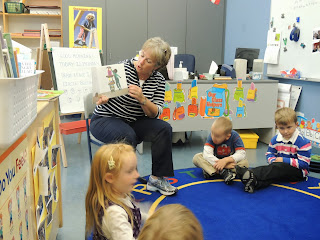On September 23-27, I conducted an on site visit. The focus was literacy. The classrooms I visited were k-5 plus the members of the EDU 590 course we began in August.
Everyone was off to a great start. Classrooms were buzzing with students reading, writing, and focusing on learning. Following is a photo-tour I hope you enjoy!!
Great job team!!!
Your students thank you for all of your hard work!!
Pre-K students are immersed in rich language - listening to stories...
learning the basic "academic" vocabulary used in school ...
learning how to spell and read their names.
Kindergarten students are off to a great start learning the concepts of print by writing and reading! Their enthusiasm is obvious. Mrs. Kayla and her students have already completed the first month of the Fountas and Pinnell curriculum! Bravo!!
First grade students are using their literacy skills by writing (composing stories, spelling words, editing and revising)...
sharpening their reading skills based on individual needs with the ed tech...
working in a center....
listening to books to build vocabulary, story structures, and book language...
beginning their journey to life long literacy!
Second grade students continue with writing, poems, and reading!
The level of independence is obvious as you visit the classroom.
A special welcome to new staff member, Sarah Mason.
Third grade students are transitioning to becoming serious students.
Nonfiction texts and strategies are being taught explicitly throughout the day. They learn to monitor their own reading...identifying what they know and don't know...reading to find the information they don't have...finding text features and previewing them for meaning...finding evidence in the text to support answers...all common core strategies.
Students have learned to select books and read independently. Focusing on longer texts.
Fourth grade students are developing writing strategies focusing on the common core...
developing reading strategies using poetry...
continuing to develop the ability to monitor their own learning and work independently.
Fifth grade students are being immersed in an integrated curriculum based on the common core state standards.
As fifth grade students become more independent, time is found to focus on literacy and accelerate student progress. Here students learn to read nonfiction texts for meaning...based on the text, "The Core 6."
Embedded in the integrated curriculum is technology ... another 20th century strategy ... allowing students the opportunity to learn how to use this medium and access information.
Extra time has been given to many students as Ms. White pitches in to assist the literacy implementation. Bravo!!
High school science students learn how to use maps - a nonfiction text - and articles about maps - another form of nonfiction texts.
Science students make real world connections based on the nonfiction text selected for study in class...another common core connection. Bravo!!
High school theater students research recognized artists during class. They use a porta-portal to locate the information they need as the teacher models. Information literacy is one of the key components of the 21st century.
Individual student conferences are held to assist students in planning their research and constructing their projects...writing included. Bravo!!
High school students studying web page design reviewed the process of reading a technical manual...a skill that will be needed in the real world.
Students will use these reading strategies throughout their life. Bravo
High school history students studying American History are taught how to access text books as well as articles. The instructional strategies used include common core standards: speaking, listening, writing, and reading...all leading to increased comprehension. Excellent!!!















































